Paint
| METRICATION: 99% complete | |||
 |
|||
| Metric | Non-metric | ||
| All paint container volumes in litres and millilitres | Paint brush sizes in dual units | ||
| Paint coverage in square metres per litre | |||
Paint containers
Apart from medicines, which went metric in 1969, paint was the first liquid product to be sold to the public in metric volumes. Metric tins of paint first went on sale in June 1971.
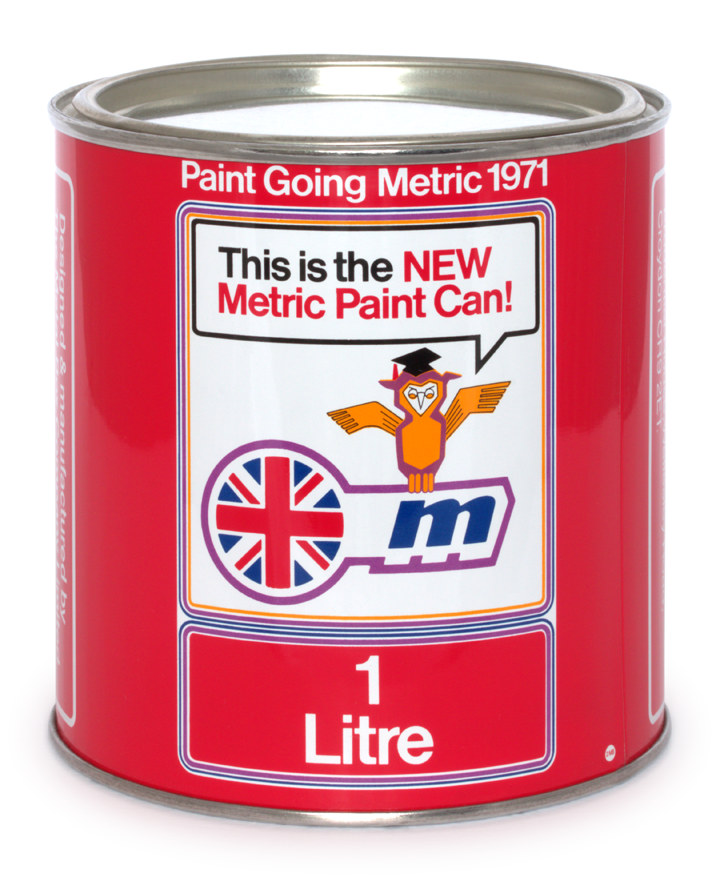
A demonstration metric paint can – 1970
The need for metrication
The UK’s desire to metricate paint tin sizes predates the Government’s decision in 1965 for the country to go metric.
In 1960, the UK co-founded the European Free Trade Association (EFTA). All European Economic Community (EEC) and EFTA countries were represented on the European Committee of Paint, Printing Ink and Artists’ Colours Manufacturers’ Associations. The UK was represented by the Paintmakers Association of Great Britain Limited (PA).
In November 1964, the EEC put forward a draft standard for paint containers listing 20 sizes between 50 ml and 10 litres. Britain led the way in persuading other EFTA and EEC members to agree to reduce this number, and by 1966 the number of different sizes had been reduced to nine. In agreement with other counties, the Paintmakers Association later added a 20-litre size.
Following the agreement of a standard range of container volumes, European manufacturers also sought to reduce the variations of dimensions of paint containers, especially of base diameters, in order to create a common European engineering standard.
In 1967, as the likelihood of the UK joining the EEC grew, it became increasingly desirable for the UK paint industry to adopt a new standard range of sizes to take advantage of the forthcoming opportunities for trade in Europe. It was obvious that the current imperial size range would not be able to be sold in any other European country, and that a new standard metric range needed to be chosen from the newly rationalised EFTA and EEC range that had just been negotiated by the the Paintmakers Association.
Meanwhile, following the Government’s announcement in 1965 that industry should change to metric, a Metric Panel had been set up by the British Standards Institution (BSI), and in February 1967 it published a detailed programme for the construction industry. This meant that work on site in metric projects would start in 1970 and that the whole of the construction industry would be metric by the end of 1972. Consequently, as suppliers to the construction industry, paintmakers were committed to full metrication of their products by the end of 1972.
With a burgeoning export market, and a large section of its domestic market, both requiring paint to be supplied in metric container sizes, it made no economic sense to retain a separate imperial range purely for the domestic retail market – the imperial range had to go. In any case, the rest of the economy was about to go metric too. In practice, the metric sizes that were chosen to supercede the imperial sizes, differed in volume by no more than 12%.
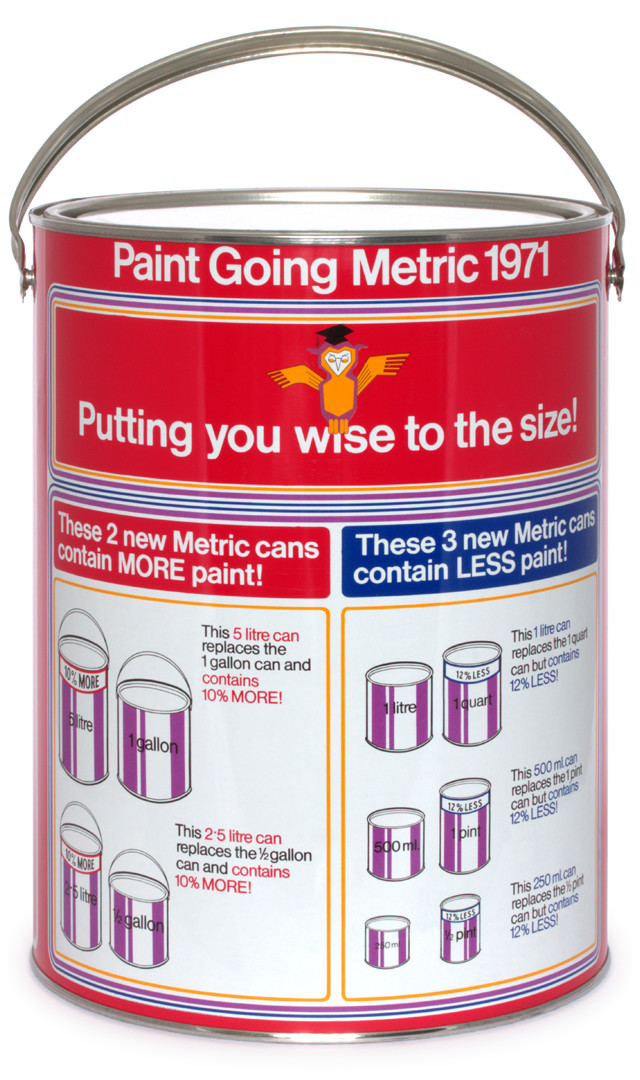 |
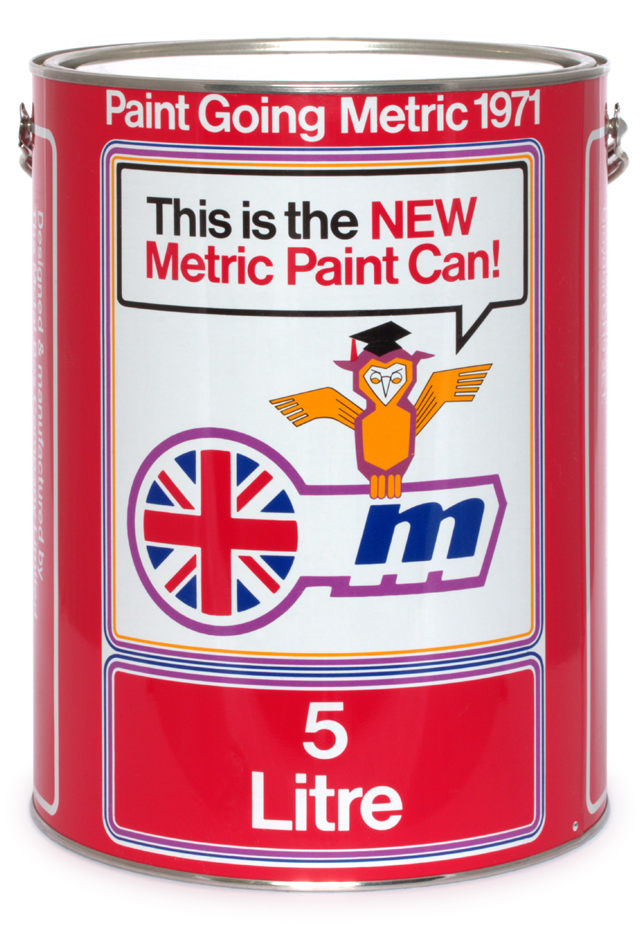 |
|||
| Metric paint can sizes – 1970 | ||||
The Paintmakers Association initially planned for a size-by-size change to be completed by 31 December 1972. However, with the cooperation of the tin box manufacturers, plans for the change were compressed into a six month period, with completion before 1972.
Selection of the new standard metric sizes
In order to choose the best sizes from the newly agreed range for a new UK standard range, the Paintmakers Association conducted a survey to establish which metric sizes were in most common use in Western Europe at that time. In practice the selection process in the UK was easier than it was for other European countries, many of whom had their own individual standard ranges, some selling by volume, some by weight. It was also harder to justify the need for change in countries where existing sizes were already metric.
Paint container sizes in Europe – 1967
| Size | Countries |
| 20 L | B, CH, DK, FIN, NL, P, UK |
| 15 L | DK, NL |
| 10 L | B, CH, D, DK, FIN, NL, N, P, E, S, UK |
| 5 L | A, B, CH, D, DK, F, NL, P, E, S, UK |
| 4 L | NL |
| 3 L | CH, D, E, F, N |
| 2.5 L | D, DK, FIN, NL, S, UK |
| 2 L | P |
| 1 L | A, B, CH, D, DK, E, F, FIN, NL, N, P, S, UK |
| 750 ml | D, DK, F, NL |
| 500 ml | A, B, D, DK, E, F, FIN, NL, P, S, UK |
| 330 ml | N, S |
| 250 ml | A, B, D, DK, E, F, FIN, NL, P, S, UK |
| 125 ml | DK, FIN, NL, P, S |
| 110 ml | N |
| 100 ml | D, F, NL, P, UK |
| 62.5 ml | DK, S |
| 50 ml | D, NL, P |
In the UK, once the new metric size range had been decided, a joint committee was set up between the Paintmakers Association and the British Tin Box Manufacturers Federation (BTBMF) in order to ensure identical representation to the British Standards Institution (BSI) of a range of containers which would be both standardised by capacities and at the same time be an engineering standard.
Some of the issues considered included:
- Whether to change existing imperial range base diameters, or to alter the height of the tins, or both.
- Whether in the very small tinlet size to choose 100 ml or 125 ml.
- Whether to have a range stepped 1 L, 2 L, 4 L, or to follow most other European countries and have 1 L, 2.5 L and 5 L.
The PA and BTBMF mutually decided to shorten, or heighten tins, but to do so on existing base dimensions. For the PA, the main reason was that the area occupied by a tin on a shelf was more important than its height. For the container manufacturers, the cost of converting automated tinplate lines was much less if the diameter of the tin did not need to be changed.
For the tinlet size, 100 ml was chosen because the required base diameter more closely matched an existing engineering standard.
A 1, 2, 4 litre range, more closely matched the straight doubling up of the old imperial sizes 1 quart, ½ gallon, 1 gallon. However, there was very little use of 2- and 4-litre containers in the rest of Europe, so this option was not chosen.
At a time of rising steel prices, an argument in favour of the 1, 2.5, 5 litre range, was that increasing the volume of the two largest retail tin sizes would result in a more beneficial ratio of paint volume to tin cost.
 |
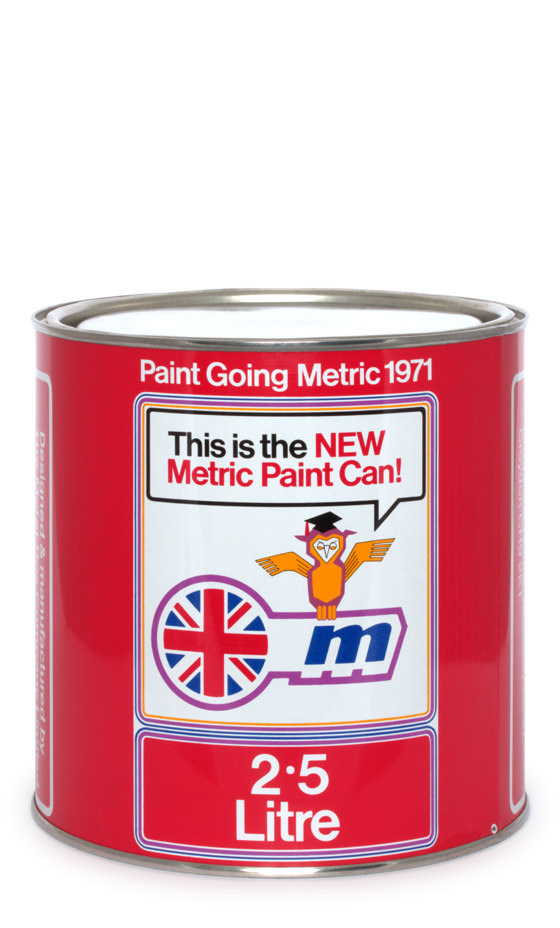 |
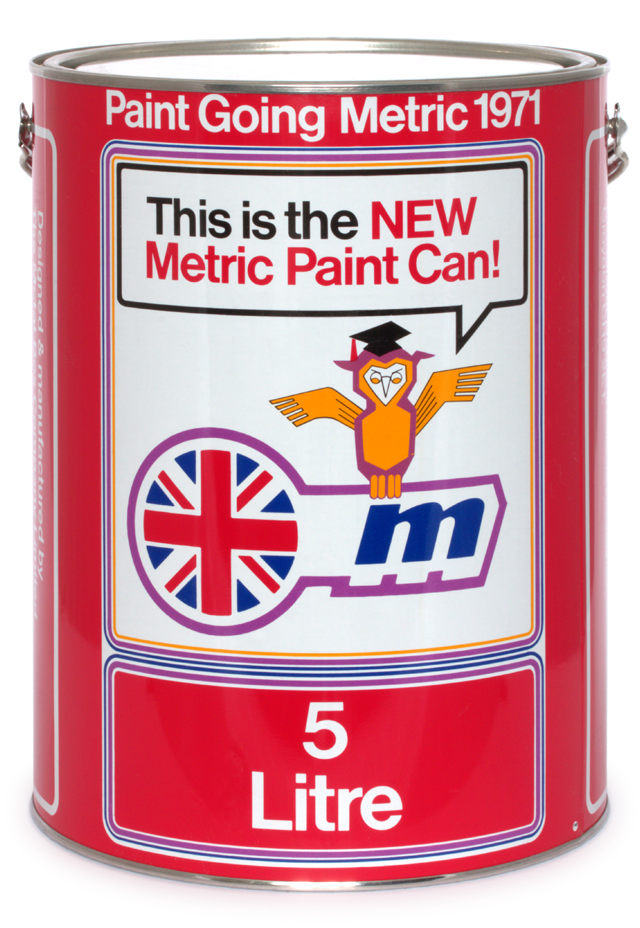 |
||
| The new 1, 2.5, 5 litre range of paint tins – 1970 | ||||
It seems that a 1-2-5 series for container sizes was not considered at the time. A 1-2-5 series, like that chosen for decimal coinage, would have resulted in a retail size range stepped 200 ml, 500 ml, 1 L, 2 L and 5 L. If extended to include smaller and larger sizes, this would have given a logical range stepped 100 ml, 200 ml, 500 ml, 1 L, 2 L, 5 L, 10 L, 20 L, 50 L, 100 L and 200 L.
With the old imperial sizes, there were two common variants of the half-gallon size – a tall tin and a squat tin. Further increasing the height of the tall tin would have made it unwieldly, so it was the squat tin alone that was kept for adaption to make the new 2.5 L tin. This rationalisation was another benefit of the change.
With the rest of the Commonwealth committing to metrication programmes of their own in the 1970s, there was every expectation that the world was about to become 100% metric for trade. The UK paint industry could not afford to be left behind. It was hoped, and expected, that the USA and Canada would also both soon adopt the 5 L tin as the main standard size for paint tins, ending the confusion caused by the different gallon-sizes used in North America.
The new UK metric range that was eventually decided on meant that some retail sizes would be smaller and other sizes larger than the old imperial range.
| Old imperial size | Size change | New metric size | Date introduced |
| 1 gallon | 10% more | 5 L | June 1971 |
| ½ gallon | 10% more | 2.5 L | mid July 1971 |
| 1 quart | 12% less | 1 L | end August 1971 |
| 1 pint | 12% less | 500 ml | October 1971 |
| ½ pint | 12% less | 250 ml | October 1971 |
In 1970, the BSI published the new standard, BS 1262 Round tins for liquid paints, varnishes and allied products (volume packed).
Nominal base diameters of metric paint tins
| Capacity | BS 1262 (1970) | Europe (1971) |
| 250 ml | 74 mm | 73 mm |
| 500 ml | 74 mm | 86 mm |
| 1 L | 113 mm | 108 mm |
| 2.5 L | 154 mm | 140 mm |
| 5 L | 176 mm | 180 mm |
| 10 L | 219 mm | 230 mm |
A comparison of the 1970 British standard and the state of progress towards a European standard in 1971, reveals the lack of a common standard for container dimensions. However, the main goal of a standard range of container volumes thoughout Europe had been achieved.
Large containers
In addition to standard retail paint container sizes, the Paintmakers Association and British Tin Box Manufacturers Federation also addressed the need for metric standards for larger paint containers, including those used for industrial and automotive paints.
The 10-litre size was an obvious next-step progression for the new size range, and was already in use in other European countries. It was hoped that a new 10-litre standard size would replace the uneconomical production runs of 2-, 2½-, and 3-gallon containers that were being made at the time.
A 20-litre size was also chosen for similar reasons.
A 25-litre tinplate container, was adopted into the new metric paint container range on account of it already being economically produced for use in the oil industries. However, the use of 25-litre containers would be restricted for low-density paints only. It was anticipated that 25-litre containers of high density paints could cause issues with future health and safety legislation which were being planned to limit the weight one person may move or lift unaided.
For container sizes greater than 25 litres, it was acknowledged that paint manufacturers had little influence on container specifications, owing to the international nature of the standard containers used, namely the ICC 17E type 45-imperial-gallon (204.57-litre) drum, and the fact that the paint industry was not a major user of these containers.
It was anticipated that forthcoming metrication of oil industry containers would settle on a new 200-litre standard, which the paint industry could adopt. Meanwhile, for the short term, it was decided that the paint industry would use the ICC 17E 45-imperial-gallon drum as a 205-litre container. Similarly, where 40-imperial-gallon (181.84-litre) drums were used for paint, these would be filled with and labelled as containing 180 litres.
The Paintmakers Association also agreed the specifications for a standard 1000-litre container for industrial use.
Today, more than 50 years later, the 205-litre container is still standard, and the 180-litre and 25-litre containers have been dropped.
Related industries
When selecting the new metric size range for paint containers, the Paintmakers Association wanted to ensure that the sizes chosen were also suitable for filling standard weights of putties and mastics (much of which were made by paint manufacturers), and, if possible, were also acceptable to the oil industry for greases.
The Paintmakers Association were able to agree with the National Association of Putty and Building Mastics Manufacturers that their products, although continuing to be sold by weight, would nevertheless be packed into the agreed standard range of tins.
Weights of putties and mastics packed in metric containers
| Container volume | Weight of contents |
| 250 ml | 500 g |
| 500 ml | 1 kg |
| 1 L | 2 kg |
| 2.5 L | 5 kg |
| 5 L | 10 kg |
| 10 L | 20 kg |
The Oil Companies Materials Association also agreed that their grease products, which have a density of about 1 kg/L, could, since they were also sold by weight, be filled into the same standard range of containers. Their 1 pint, 1 quart, and 1 gallon would become 500 ml, 1 litre, and 5 litres.
By ensuring that a variety of other industries also adopted the same container sizes as paint manufacturers, the Paintmakers Association had made it possible for the tin box manufacturers to give them the benefits of long production runs.
Information campaign
In 1969, in anticipation of the forthcoming new metric tin sizes, the Paintmakers Association advised all paint manufacturers to refrain from making any major design changes to their current range of tins. Paint manufacturers also agreed to show the new metric tins’ contents in terms of metric units first, with imperial equivalents following in brackets. In 1971, legislation did not yet permit metric-only labelling of goods.
In July 1970, the major manufacturers of the Paintmakers Association agreed to form a working party and provide funding for a phased public relations programme. Apart from medicines, which had already gone metric in 1969, paints would to be the first liquid product sold to the public in metric volumes, so a lot of thought went into planning the publicity campaign for the change. The working party overseeing the change included a representative from the Metrication Board and a tin manufacturer, The Metal Box Company. The Metal Box Company contributed the design cost and the manufacturing facilities for a publicity sample range of new metric containers.
At the time there was some concern that paint stockists might expect to be able to return imperial stock as soon as the new metric stock became available. A decision was made that once a stockist started selling a metric-size tin, no further imperial tins would be sold. In practice this meant that for a given paint colour, all imperial stock would be sold before metric tins appeared on shelves. The first metric tins to appear on shelves were the faster moving whites and off-whites.
 |
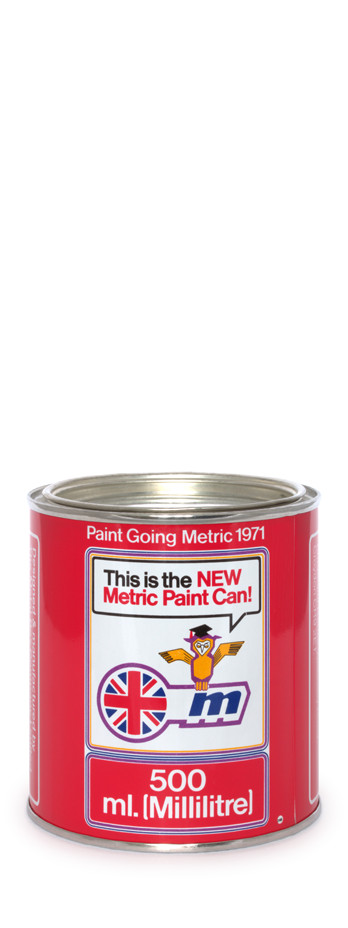 |
 |
 |
 |
| A set of demonstration metric paint tins – October 1970 | ||||
In October 1970, all known paint wholesalers were sent a set of the new demonstration metric volume tins. This coincided with a conference held by the Paintmakers Association for the retail and trade press.
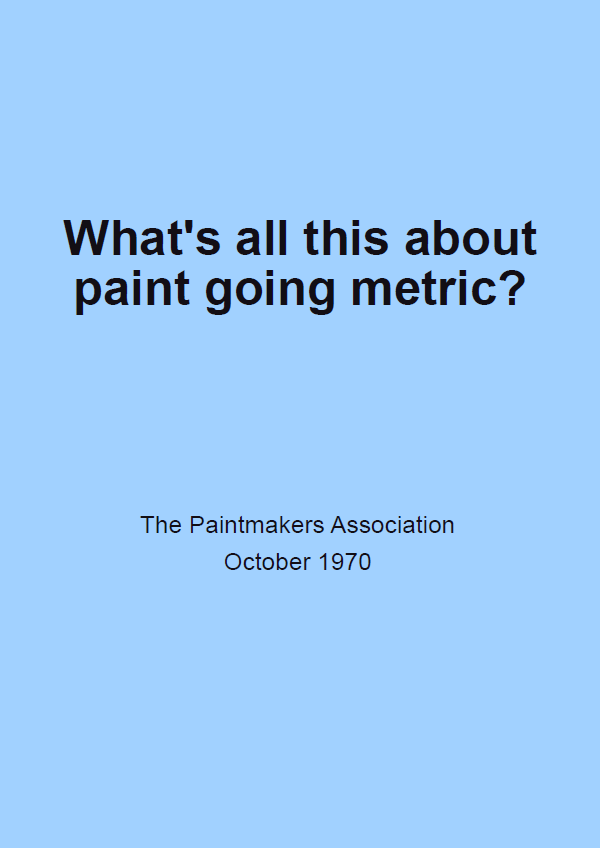
click to access the leaflet text
In November 1970, about 20 000 paint retailers were sent copies of a leaflet entitled, “What’s all this about paint going metric?”, together with a plastic template showing the volume changes on one side and an exact reproduction of the metric tin sizes on the other. The template could be used to plan for any changes needed in shelving. Retailers were also able to request a set of the demonstration metric tins at cost price (24 shillings and 6 pence).
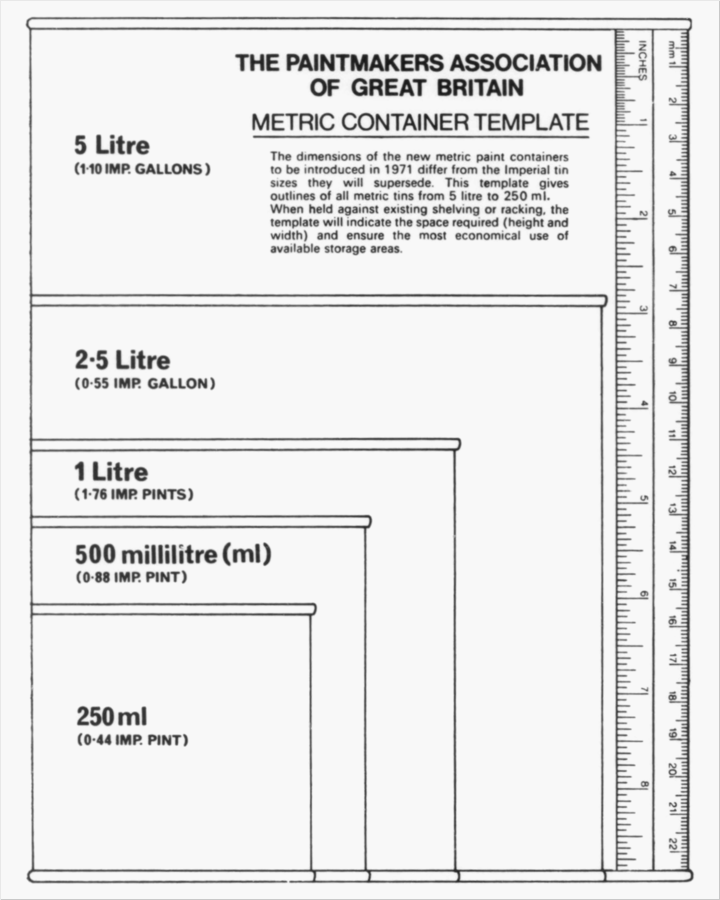
Metric container template – 1970
The “What’s all this about paint going metric?” leaflet explained,
“Britain’s going metric. By 1975 we’ll be buying our beer in litres, meat in kilos and furnishing fabrics in metres. And the same will be so of paint, putty and plywood.”
In 1970, concern was growing about the continued absence of the Government’s publication of a White Paper on metrication. However, there was still every expectation that the metrication programme in other sectors would proceed as smoothly as it had done in the construction industry, of which paint manufacture was a part.
In February 1971, the new metric tins were demonstrated on the Paintmakers Association’s stand at the annual Walpadex Exhibition. The Paintmakers Association also held question-and-answer sessions at the annual meeting of the Wallpaper, Paint and Wallcovering Retailers’ Association, which was held at the same time.
In March 1971, timed in order to make June and July copy dates, the Paintmakers Association released the story to the women’s press. A final press conference was held at the end of May 1971, for home-page editors.
In June 1971, point-of-sale reference posters were sent to about 20 000 paint retailers and wholesalers. The poster was designed as an aid for both retailers and customers in their first encounter with the volume differences, and what the changed volumes meant in spreading capacities.
In October 1971, during a presentation made at the 49th Annual Meeting of the Federation of Societies for Paint Technology in Detroit, the Director of the Paintmakers Association commented on the UK’s successful metrication of paint container sizes,
“The only still persistent criticism is that some of the largest manufacturers decided to omit the 250 ml size, which replaced the ½ pint, sales of which had in any case been declining for many years.”
Keith S.Flory, Director of the Paintmakers Association – 28 October 1971
The Metrication Board
The Metrication Board produced a leaflet which remained available for several years after the introduction of the new metric sizes.

Paint metrication leaflet – 1973


